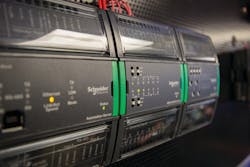As the drive continues to integrate building systems and streamline the process of facility control, it is reasonable to assume that adding commercial energy management services will enable a security systems integration firm to have a more marketable, full-service offering to customers while providing increased return on investment.
As new technologies allow for greater integration between all the systems contained in modern commercial buildings, the ability to offer a complete range of services, from security to energy management, can be a real advantage that offers ROI for a security integrator.
The challenge is in executing the growth into this new business line so your firm can deliver effective energy management for its customers. Expanding into this market is no small undertaking, because while it may seem the two industries are very similar — with inputs, outputs, control points and data gathering — that’s where the similarities effectively end.
Adding Resources
Moving a systems integration firm into the energy management field will require changes throughout the company. With proper training, your existing computer savvy, technical staff will grasp the controls industry front-end software and integration practices. In the field, they will be a great asset for system network configurations and startup programming.
There are essential personnel to add in order to be successful as an energy management services provider. First, you will need an experienced energy engineer. This role is crucially important, so it may not be prudent to select a young engineer just out of college. The best person for this position has experience in commercial building automation and energy management as well as central plant, air handler, boiler and overall facility operational knowledge.
Next, it is important to provide the staff engineer with trained support. While you should be able to use some of your existing security staff, a heating, ventilation and air conditioning (HVAC)-trained technician will be a valuable asset. A young, energetic HVAC tech with just a few years of field experience — even if it is light commercial — will be an important asset.
The Engineer’s Tools
Fortunately, there are a variety of tools and resources to enable your energy engineer to make the right choices and employ energy management best practices that can squeeze every bit of energy savings available from a building.
ASHRAE (Formerly the American Society of Heating, Refrigerating and Air Conditioning Engineers, www.ashrae.org), is a building technology society with more than 54,000 members. Like ASIS for the security industry, ASHRAE has led the way in guiding the design principles and best practices for commercial HVAC and refrigeration systems for more than 100 years. Committed to standards, research and technology, ASHRAE has created an exhaustive catalog of the base monitoring, efficiency formulas, algorithms and strategies to keep energy-consuming systems operating at optimal efficiencies.
Energy Star is a U.S. Environmental Protection Agency (EPA) program that promotes superior energy efficiency in buildings. The Energy Star Portfolio Manager is an online tool used to measure and track energy and water consumption, as well as greenhouse gas emissions. This tool enables energy managers to benchmark a building’s energy performance and compare it to similar facilities. The Energy Star award recognizes buildings with superior energy efficiency.
Additionally, manufacturers that specialize in integrated solutions are valuable sources of information and insight into the industry. Often, product manufacturers will provide customers with the training and expertise required to install and service these systems. They can help your engineer understand not only the specifics of each of their systems as a stand-alone, but also how to integrate various systems in practical, real-world applications.
Access Control: The Gateway
In integrated buildings, access control often serves as a gateway to the energy management system. The proximity/smart card indicates to all the building systems who is in the facility — especially during off-hours such as nights or weekends, when many of a building’s systems are turned off to save energy.
As the common thread in building integration, it is the card that causes the security systems integrator to be involved with all of the other applications, including energy management, and having expertise in all of these systems and applications is an advantage. For example, the swipe of an access card can be a signal to not only unlock doors and trigger video surveillance cameras but to also turn on lights and activate the HVAC to programmed set points in specific areas of the building.
The goal of the newest technologies is to provide facility operators with very precise energy management and control in real time. Instead of using one engineered sequence that was developed for load baseline conditions to operate a commercial central chilled water plant, multiple energy savings strategies can be implemented at once in real time. Using the equipment manufacturer’s optimal operational baseline settings as a reference, adjustments are continuously updated, to keep up with current environmental conditions and variables based on time, temperature, humidity, dew point, consumption and radiant energy readings, to name a few. Available today from several manufacturers, this technology can be introduced without replacing all of the existing controls equipment.
These same strategies can also be introduced into lighting control systems. With advances in LED lighting and dimming control, significant energy savings are a reality. Lighting control integrated within the whole facility energy management system provides the user with another solution for operational savings.
Bridging Security and Energy Management
Applying some of this energy management technology to your security customers is a natural progression. The beauty of most energy management hardware is that can be as complex as necessary, depending on the application. Consider, for example, a customer with a complex security sequence for access control with requirements that are too complicated for the customer’s VMS or card access system to handle. One solution is to hire a PLC contractor to manage the hardware and program the inputs, control outputs and control loops. While PLCs are a great way to accomplish the task, they are considerably more expensive than a building automation controller.
Instead, the building automation controller can actually serve as an “all-in-one” unit containing the inputs and outputs that connect to the sensors and control relays running the physical access sequence. Inside the building automation controller is the power to run even the most complex sequences and, unlike most security controllers, you now have full Boolean logic, time-based logic and algebraic and trig math calculations at your disposal. In fact, there are very few security sequences that cannot be accomplished at a third the cost of PLCs using these building automation controllers.
Security integrators can also take advantage of physical security monitoring data and, using open protocols and communications standards, improve the energy management and efficiency of a facility. For example, security data and point status information can be delivered to the BAS to provide more accurate information for occupancy schedules and room set points.
Paul Strohm is vice president of the InsideIQ Building Automation Alliance (www.insideiq.org), an international alliance of building and facility automation companies. He is also president and COO of C & C Group, a Lenexa, Kan.-based facility services provider.


